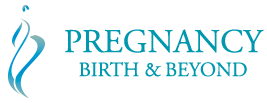
Sometimes there are contributing reasons for the baby being in a breech position. Reasons like when the baby is born premature (remember the earlier the pregnancy, the more likely a baby is to be in the breech position.) Some women have a septum in their uterus. A septum is a structure that can divide the uterus. A septum makes it more difficult for the baby to settle into a head-down position. If a woman has a growth in her pelvis such as a tumour or fibroid, this may also prevent the baby from turning to a head-down position.
Other reasons that increase the likelihood of a breech baby include:
An abnormality of the baby, placenta praevia, multiple pregnancies, excessive amniotic fluid, the unusual shape of a woman’s pelvis or if the woman has very weak or very tight abdominal muscles.
However, a breech baby can occur in a healthy woman with a healthy baby. In these cases, a baby simply likes being the other way around.
A midwife or doctor can usually diagnose a breech baby during pregnancy, although occasionally it is not found until a woman is in labour. The midwife or doctor usually can feel the soft bottom near the pelvis and the baby’s head somewhere in the upper abdomen. Often women who have a breech baby report that they feel a hardball or a very sore spot under their ribs.
Though most breech babies will turn naturally before their due date, some remain in the breech position. It is then that the woman and her partner will be faced with choices on what to do regarding trying to turn the baby and what is the best way to give birth.
My doctor said that he would prefer to do a caesarean as my baby is breech. I would like to avoid a caesarean if at all possible. What can I do?
What is the best way for a breech baby to be born? A study called the Term Breech Trial endeavoured to answer this very question. The conclusion of the study reported that overall it was safer for full-term babies in the breech position to be born by caesarean birth. While the study design has some serious flaws it resulted in many doctors recommending a caesarean for breech babies.
Since the results of the Term Breech trial were published the level of skill for midwives and doctors in assisting breech births has declined greatly. If you chose to have a vaginal breech birth you will need to seek a skilled birth attendant (and such a person may be difficult to find). You will also need to find out what type of breech is it? A complete breech has far fewer complications than a footling breech for example.
It is important to remember that both vaginal breech births and caesarean births carry risks. There is plenty of information both in books and on the internet about breech babies and breech births. There is a lot to consider when choosing the right option for birth and it is important to discuss the issues with the health professional providing your care.
I have heard about a procedure where a doctor tries to turn the baby into a head-down position. Can you provide me with further information?
The procedure where a doctor attempts to turn a breech baby to head down position is called an ‘external cephalic version’. Research clearly supports that the external cephalic version substantially reduces the number of babies who remain in the breech position. The research also says that an external cephalic version should not be done until the baby is full-term (at least 37 weeks). This helps reduce the number of babies who turn back to the breech position.
During an external cephalic version, a doctor manipulates the baby externally, through the woman’s abdominal wall, to make the baby roll forwards or backwards. The doctor uses minimal force. Sometimes medication is given to help relax the woman’s uterus. The external cephalic version is not without risks. There is an increased risk of fetal distress, spontaneous rupture of membranes and problems with the placenta. The risks and benefits should be discussed with a doctor or midwife.
Is acupuncture successful in turning breech babies into the head-down position?
Acupuncture has been used successfully to turn breech babies. I have seen two well-controlled research studies supporting its use. They found that acupuncture can successfully turn up to 70% of breech babies. Treatment can be commenced as early as 32 weeks. The most common treatments used by acupuncturists are moxibustion alone or moxibustion in combination with acupuncture. Moxibustion is a method of applying heat to an acupuncture point using a cigar-like stick of the dried herb moxa (Fursland, 1992). The acupuncture point used to turn breech babies is located just near the little toe. If choosing this method it is important to consult a qualified acupuncturist.
Are there any natural methods of helping a breech baby to turn?
There are a number of alternative methods which have been used to assist the breech baby to turn. Pulsatilla, a homoeopathic remedy, has been claimed to be successful by some practitioners. Pulsatilla can be given as a single dose and helps stimulate the baby to move. To obtain Pulsatilla you would need to consult a qualified homoeopath.
The positioning has been recommended by some as a method to encourage the breech baby to turn. Balaskas (1989) recommend walking an hour a day. The theory behind this is that the baby’s head is the heaviest part of the baby’s body and will move down because of gravity. Another positioning technique that has been used is one that has the woman’s bottom higher than her head. This type of position discourages the baby’s bottom from settling into the pelvis.
One way of doing this is by getting onto the floor in the hands and knees position and then place your head on the ground (known as the knee chest position). Try this exercise three times per day for 15 minutes at a time. There has been some uncontrolled studies that indicate this last method has a high incidence of breech babies turning. Further research on positioning techniques is needed, so we know if they are effective or not. Remember before commencing any treatment it is important to consult a qualified health professional.
Reference list
- Balaskas, J. (1989). New active birth: A concise guide to New active birth: A concise guide to natural childbirth. London: Unwin Paperbacks.
- Banks, M. (1998). Breech birth: Woman-Wise. Birthspirit
- Beal, M. W. (1998) Women’s use of complementary and alternative therapies in reproductive health care. Journal of Nurse-Midwifery, 43 (3), 224-234.
- Cardini, F., & Wiexin, H. (1998) Moxibustion for correction of breech presentation. The Journal of the American Medical Association, 280 (18), 1580-1584.
- Charlish, A. (1995) Your natural pregnancy. Australia:
- Enkin, M., Keirse, M. J. N. C., Renfrew, M., & Neilson, J. (1995). A guide to effective care in pregnancy and childbirth (2nd ed.). Oxford: Oxford University Press.
- Fursland, E. (1992) How to do a baby a good turn.
- Hannah, M. E., Hannah, W. J., Hewson, S. A., Hodnett, E. D., Saigal, S. & Willan, A. R. (2000). Planned caesarean section versus planned vaginal birth for breech presentation at term: A randomised multicentre trial. The Lancet, 256: 1375-1383.
- Mehl, L. E. (1996). Hypnosis and conversion of the breech to the vertex presentation. MIDIRS , 6, 52.
Revised on 6th December 2021


Recent Comments